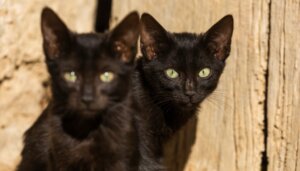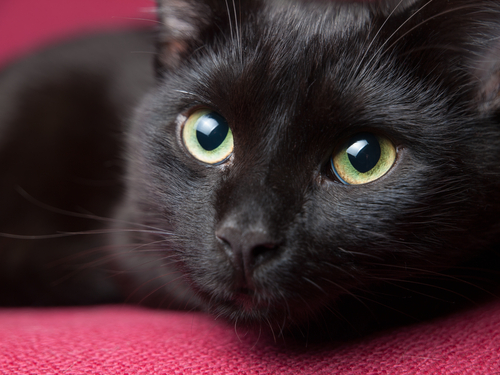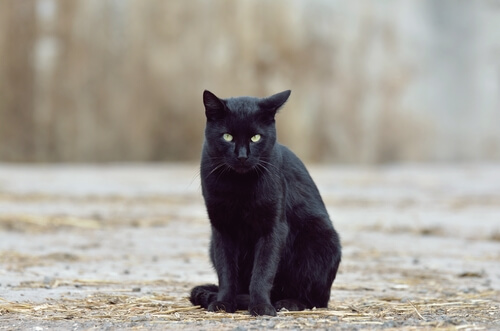7 Curious Facts About Black Cats


Written and verified by the biologist Georgelin Espinoza Medina
Do you like black cats? They range from being objects of adoration to being symbols of bad luck. If you have one at home or would like to adopt one, we bring you all the aspects that are hidden in their fur, because no matter the breed or color, they’re living beings and pets like any other, demanding love and affection.
Curiosities about black cats
Now, without further ado, here are 7 interesting facts about black cats.

1. Their coloring is due to the pigment eumelanin
There are a variety of colors present in cat fur. These are produced by a pigment called melanin and its two types, eumelanin which gives a dark coat, and pheomelanin which gives the orange tones.
The diversity of colors is due to the action of different genes and the interactions within them. Some genes control the presence of pigments, while others regulate the density and distribution. In this way, we have cats with solid patterns, some striped, and others with spots.
A black cat’s coat is very beautiful. The black color is produced by the presence of eumelanin. In addition, they have a gene that suppresses striped or spotted patterns, which creates a solid, beautiful, and bright color throughout the body.
2. They’re symbols of bad luck for some
Despite their beautiful color and brightness, black cats have been accompanied by unfortunate myths and legends. In the Middle Ages, it was believed that witches were transformed into these cute little cats. In this way, they were related to sorcery, spells, and bad omens, so their presence was frowned upon and they could even be chased and burned at the stake.
3. They’re sacred in some cultures
Another curiosity about black cats is that they weren’t always considered symbols of bad luck and reputation. In some cultures, they’re treated as sacred animals. A very clear example was in ancient Egypt, where the kittens were believed to possess divine qualities and were related to the goddess Bastet (the goddess of protection, love, and harmony, represented as a cat-headed woman).
In addition, they were mummified with their owners, because of the belief of reincarnation in the afterlife. In Scottish culture, black cats were also venerated, and having one in the home was associated with good luck.
4. They have the lowest adoption rate
There seems to be a relationship between coat color and cat adoption. Studies carried out in the United States, in 2002, have shown that black and brown cats have the lowest adoption rates. This fact may be related to the negative myths that revolve around these animals.
5. They’re less aggressive
One of the curiosities of black cats is that it has been demonstrated that they have more gregarious tendencies and greater tolerance towards other cats. In addition, they’re more adaptable. These qualities also give them greater reproductive success than other colored cats.
Although black cats are associated with bad luck, the truth is that they are very loving pets, which don’t have aggressive behavior towards cats of different colors. According to an analysis based on an online survey, in which variable behavioral situations were evaluated (in daily life, in a veterinary clinic and during handling), the most problematic tendencies were in females of two or three colors.
However, more studies are needed to confirm this apparent and interesting link between temperament and coat color.
6. Pure breed or mixed breed
A cat’s black color can be present in both common (non-breed) kittens and those belonging to a pure or mixed lineage. An interesting type to mention is the Bombay, a medium-sized cat with a beautiful, shiny black coat. In addition, it’s a very peaceful, affectionate and a perfect companion animal.
7. There’s a black cat day
As a last interesting fact about black cats, we should mention that they have a special day devoted to them. It’s October 27th but it’s only recognized in Great Britain and Northern Ireland.

What’s so special about black cats?
So, after getting to know these facts about black cats, we realize how special these little animals are. Apart from the color of their fur and the myths that have accompanied them over the years, they’re beautiful, affectionate, and peaceful cats. They’re loving pets just waiting to be loved and pampered back, just like other cats. For sure, you won’t regret adopting one!
Do you like black cats? They range from being objects of adoration to being symbols of bad luck. If you have one at home or would like to adopt one, we bring you all the aspects that are hidden in their fur, because no matter the breed or color, they’re living beings and pets like any other, demanding love and affection.
Curiosities about black cats
Now, without further ado, here are 7 interesting facts about black cats.

1. Their coloring is due to the pigment eumelanin
There are a variety of colors present in cat fur. These are produced by a pigment called melanin and its two types, eumelanin which gives a dark coat, and pheomelanin which gives the orange tones.
The diversity of colors is due to the action of different genes and the interactions within them. Some genes control the presence of pigments, while others regulate the density and distribution. In this way, we have cats with solid patterns, some striped, and others with spots.
A black cat’s coat is very beautiful. The black color is produced by the presence of eumelanin. In addition, they have a gene that suppresses striped or spotted patterns, which creates a solid, beautiful, and bright color throughout the body.
2. They’re symbols of bad luck for some
Despite their beautiful color and brightness, black cats have been accompanied by unfortunate myths and legends. In the Middle Ages, it was believed that witches were transformed into these cute little cats. In this way, they were related to sorcery, spells, and bad omens, so their presence was frowned upon and they could even be chased and burned at the stake.
3. They’re sacred in some cultures
Another curiosity about black cats is that they weren’t always considered symbols of bad luck and reputation. In some cultures, they’re treated as sacred animals. A very clear example was in ancient Egypt, where the kittens were believed to possess divine qualities and were related to the goddess Bastet (the goddess of protection, love, and harmony, represented as a cat-headed woman).
In addition, they were mummified with their owners, because of the belief of reincarnation in the afterlife. In Scottish culture, black cats were also venerated, and having one in the home was associated with good luck.
4. They have the lowest adoption rate
There seems to be a relationship between coat color and cat adoption. Studies carried out in the United States, in 2002, have shown that black and brown cats have the lowest adoption rates. This fact may be related to the negative myths that revolve around these animals.
5. They’re less aggressive
One of the curiosities of black cats is that it has been demonstrated that they have more gregarious tendencies and greater tolerance towards other cats. In addition, they’re more adaptable. These qualities also give them greater reproductive success than other colored cats.
Although black cats are associated with bad luck, the truth is that they are very loving pets, which don’t have aggressive behavior towards cats of different colors. According to an analysis based on an online survey, in which variable behavioral situations were evaluated (in daily life, in a veterinary clinic and during handling), the most problematic tendencies were in females of two or three colors.
However, more studies are needed to confirm this apparent and interesting link between temperament and coat color.
6. Pure breed or mixed breed
A cat’s black color can be present in both common (non-breed) kittens and those belonging to a pure or mixed lineage. An interesting type to mention is the Bombay, a medium-sized cat with a beautiful, shiny black coat. In addition, it’s a very peaceful, affectionate and a perfect companion animal.
7. There’s a black cat day
As a last interesting fact about black cats, we should mention that they have a special day devoted to them. It’s October 27th but it’s only recognized in Great Britain and Northern Ireland.

What’s so special about black cats?
So, after getting to know these facts about black cats, we realize how special these little animals are. Apart from the color of their fur and the myths that have accompanied them over the years, they’re beautiful, affectionate, and peaceful cats. They’re loving pets just waiting to be loved and pampered back, just like other cats. For sure, you won’t regret adopting one!
All cited sources were thoroughly reviewed by our team to ensure their quality, reliability, currency, and validity. The bibliography of this article was considered reliable and of academic or scientific accuracy.
- Carini, R. M., Sinski, J., & Weber, J. D. (2020). Coat color and cat outcomes in an urban U.S. Shelter. Animals, 10(10), 1720. https://www.ncbi.nlm.nih.gov/pmc/articles/PMC7597961/
- Cats Protection. (s.f.). National black cat day. Consultado el 01 de mayo de 2023. https://www.cats.org.uk/support-us/events/black-cats
- Jones, H., & Hart, C. (2019). Black cat bias: prevalence and predictors. Journal SAGE, 123(4). https://journals.sagepub.com/doi/abs/10.1177/0033294119844982?journalCode=prxa
- Lepper, M., Kass, P., & Hart, L. (2002). Prediction of adoption versus euthanasia among dogs and cats in a California animal shelter. Journal of Applied Animal Welfare Science, 5, 29–42. https://pubmed.ncbi.nlm.nih.gov/12738587/
- Mair. (2019). Why black cats are great. The People´s Dispensary for Sick Animals. Consultado el 05 de mayo de 2023. https://www.pdsa.org.uk/what-we-do/blog/why-black-cats-are-great
- Morrison-Scot, T. (1952). The mummified cats of ancient Egypt. Journal of Zoology, 121(4), 861-867. https://zslpublications.onlinelibrary.wiley.com/doi/abs/10.1111/j.1096-3642.1952.tb00788.x
- Segura-Correa, J., Magaña-Monforte, J., Santos-Ricalde, R., Ek-Mex, E. (2007). Variedades de coloración en pelaje de mininos como respuesta a la expresión genética. Bioagrociencias, 13(2), 13-19. https://www.revista.ccba.uady.mx/ojs/index.php/BAC/article/view/3510
- Stelow, E., Bain, M., Kass, P. (2015). The relationship between coat color and aggressive behaviors in the domestic cat. Journal of Applied Animal Welfare Science, 1-15. https://pubmed.ncbi.nlm.nih.gov/26467020/
This text is provided for informational purposes only and does not replace consultation with a professional. If in doubt, consult your specialist.








